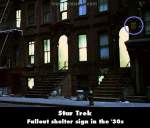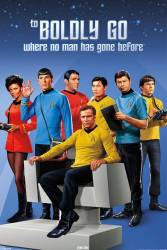Tomorrow is Yesterday - S1-E20
Factual error: Towards the end of the show the Enterprise is leaving Earth orbit and heading towards the sun. We see the Earth diminish and the moon appear looking exactly as it does from Earth. From this angle we should be seeing the "dark side" of the moon, which looks completely different. (00:40:50)
Factual error: In the opening scene on the bridge, when Spock states the planet's properties, the circumference is given in US miles; the mass is given in metric tons; the density is given in metric grams per cubic centimeter; and the atmosphere is given as oxygen/nitrogen. No scientist of Spock’s standing would mix US and metric unit systems. The atmosphere composition should also be stated reversed as “nitrogen/oxygen” with the most abundant gas first. (00:42:00 - 00:59:00)

The City on the Edge of Forever - S1-E29
Factual error: This episode takes place in NYC during the 1930's, but after McCoy's phaser is stolen in the exterior shot of the buildings a fallout shelter sign can be seen. These signs were put up no earlier than 1961.
The City on the Edge of Forever - S1-E29
Factual error: Edith Keeler says to McCoy, "My young man is taking me to see a Clark Gable movie." In 1930, Clark Gable was an uncredited bit player who had last made a film in 1926 - Edith, a New York charity worker, would not even have encountered his name.
Factual error: When they are searching for Finney hidden somewhere in the ship, all ship noises are deadened, and the heartbeats of those on the bridge are muffled by McCoy. In order to locate Finney's heartbeat the ship's auditory sensors are magnified by "one to the fourth power". That's 1x1x1x1 = 1, ie no magnification.
A Taste of Armageddon - S1-E24
Factual error: How do the Eminiarians fire a weapon based on sound ("Decibels - 18 to the 12th power") up into the vacuum of space at the Enterprise?
Factual error: Trelane has been watching Earth as it was 900 years ago (14th century in the film), but his style is more 17th century, and he mentions Napoleon who lived in the 19th century.
Factual error: The harpsichord Trelane plays is far too short and has pedals like a piano.
Factual error: If Miri's planet is a "duplicate" (meaning identical) Earth, it should have clouds. It doesn't. This remains a mistake because "duplicate" means "exactly the same," and thus the clouds should be there. The special effects crew forgot to put them in. Noteworthy: the very first thing fixed in the digitally enhanced version of this episode was the duplicate Earth. It has clouds now. (00:01:30)
Factual error: When Kirk/Spock enter/leave the Council Chamber, the doors quietly open unaided (as though there were motion detectors in operation), yet the Organian culture - determined by Spock to be approximately Class D minus on Richter Scale of Cultures - would not have had such technology. A fact overlooked by Kirk and more importantly, Spock.
Shore Leave - S1-E16
Factual error: In a scene where Kirk and McCoy are examining the tracks left by the White Rabbit and Alice, in the background behind some trees can be seen a white building (the shoot was done at Africa, USA, an animal theme park). (00:13:30)
The City on the Edge of Forever - S1-E29
Factual error: The song "Goodnight Sweetheart" was written and first performed in 1931. This episode takes place in 1930, one year before.
The City on the Edge of Forever - S1-E29
Factual error: Spock picks a lock during the great depression, but the lock is from the late 50's.
The City on the Edge of Forever - S1-E29
Factual error: When Edith Keeler is killed by the truck, it is traveling at about 25 miles per hour. At that speed and her weight around 120 pounds, she would have been thrown about 50 feet. However, she's seen dead on the ground in front of the mission where she was hit.
Factual error: If this planet is a duplicate, an exact copy, of Earth, then Lake Okeechobee, the largest lake in Florida, is wrong. Seen from space, it is much larger and more distinct than the lake shown on this duplicate.






Suggested correction: That might only true in today's standards. But we have no idea what future generations will choose to make standard.
Bishop73
This is such a trivial criticism that it should be removed to be fair. Whatever measurement standard is used in the future, it will be uniform without mixing of different unit systems.
Ken S
But that's an assumption based on what you think the future would be like. The British and Americans currently use a mix of different unit systems. While many US students use miles and pounds, they still calculate density as g/cm3.
Bishop73
No scientific or engineering facility on Earth uses imperial measures nowadays, including NASA. That is not going to change.